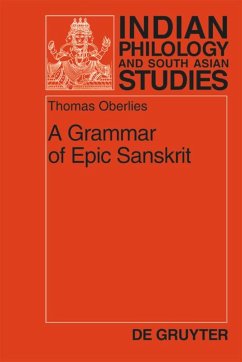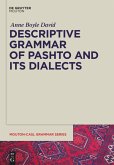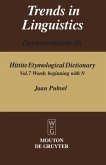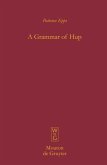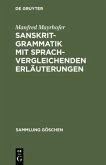The two great epics of (old) India, the Mahabharata and the Ramayana, are written in a language, which differs from so-called classical Sanskrit in many details. Both texts still are of an enormous importance in India and other countries. Because of this, a grammar describing all the different characteristics of epic Sanskrit has been missed until now. The Grammar of Epic Sanskrit will now close this gap.
Die beiden großen Epen des (alten) Indiens, das Mahabharata und das Ramaya a, sind in einer Sprache verfaßt, die sich in vielen Einzelheiten von der Hochsprache des (sog.) klassischen Sanskrit unterscheidet. Die Grammar of Epic Sanskrit bietet nun zum ersten Mal, und dies auf der Grundlage der beiden kritischen Editionen, eine (möglichst) vollständige Zusammenstellung solcher Abweichungen. In aller Regel ist dabei der Kontext, in dem eine unregelmäßige Form oder Konstruktion steht, im Originaltext und in Übersetzung gegeben. Damit transparent wird, wie es zur Entstehung der phonologischen, morphologischen und syntaktischen Besonderheiten des epischen Sanskrit gekommen ist, sind in jedem einzelnen Falle sprachwissenschaftliche Erklärungen beigegeben. Darüber hinaus finden sich in einem Anhang all die Verbformen (unter Angabe der Textstellen) verzeichnet, die innerhalb des Sanskrit zum ersten Mal im Epos belegt sind. Umfangreiche Indizes erschließen das Werk. Durchgehend angebrachte Verweise auf die entsprechenden Paragraphen der Standard-Grammatiken des Sanskrit erhöhen den praktischen Wert des Buches für den Benutzer.
Die beiden großen Epen des (alten) Indiens, das Mahabharata und das Ramaya a, sind in einer Sprache verfaßt, die sich in vielen Einzelheiten von der Hochsprache des (sog.) klassischen Sanskrit unterscheidet. Die Grammar of Epic Sanskrit bietet nun zum ersten Mal, und dies auf der Grundlage der beiden kritischen Editionen, eine (möglichst) vollständige Zusammenstellung solcher Abweichungen. In aller Regel ist dabei der Kontext, in dem eine unregelmäßige Form oder Konstruktion steht, im Originaltext und in Übersetzung gegeben. Damit transparent wird, wie es zur Entstehung der phonologischen, morphologischen und syntaktischen Besonderheiten des epischen Sanskrit gekommen ist, sind in jedem einzelnen Falle sprachwissenschaftliche Erklärungen beigegeben. Darüber hinaus finden sich in einem Anhang all die Verbformen (unter Angabe der Textstellen) verzeichnet, die innerhalb des Sanskrit zum ersten Mal im Epos belegt sind. Umfangreiche Indizes erschließen das Werk. Durchgehend angebrachte Verweise auf die entsprechenden Paragraphen der Standard-Grammatiken des Sanskrit erhöhen den praktischen Wert des Buches für den Benutzer.
"Il doit donc figurer dans la bibliothèque de tout département d'indologie." Georges-Jean Pinault in: Indo-Iranian Journal 2008
"Thomas Oberlies' book is an excellent study of the variety of Sanskrit attested in the epics, which has not been sufficiently described up to now. This is an exhaustive synchronic description ofdistinctions betwenn Epics and Paninian Sanskrit, which consistently pays special attention to the diacrony, both retrospective (from Epic back to Vedic Sanskrit) and prospective (from Epic to Middle and New Indo-Aryan). Many new interpretations are suggested by the author, and discussions of crucial problems are based on the new scholary literature. That all makes the book a deep source of knowledge for both indologists and general linguists." Holger Diessel in: Studies in Language 1/2006
"This is an extremly valuable and interesting work, and ist publication s most welcome." Stephanie W. Jamison in: Kratylos 50/2005
"A Grammar of Epic Sanskrit will be extremely useful: it draws together a great deal of material that was previously scattered through a large number of disparate sources, and in some cases had not been noted at all. Oberlies's interpretations, though inevitably sometimes open to argument, are clear and well-referenced. Compiling this book must have been very laborious, and we must all be gratefull to Oberlies for his efforts." John D. Smith in: School of Oriental and African Studies 2/2004
"Thomas Oberlies' book is an excellent study of the variety of Sanskrit attested in the epics, which has not been sufficiently described up to now. This is an exhaustive synchronic description ofdistinctions betwenn Epics and Paninian Sanskrit, which consistently pays special attention to the diacrony, both retrospective (from Epic back to Vedic Sanskrit) and prospective (from Epic to Middle and New Indo-Aryan). Many new interpretations are suggested by the author, and discussions of crucial problems are based on the new scholary literature. That all makes the book a deep source of knowledge for both indologists and general linguists." Holger Diessel in: Studies in Language 1/2006
"This is an extremly valuable and interesting work, and ist publication s most welcome." Stephanie W. Jamison in: Kratylos 50/2005
"A Grammar of Epic Sanskrit will be extremely useful: it draws together a great deal of material that was previously scattered through a large number of disparate sources, and in some cases had not been noted at all. Oberlies's interpretations, though inevitably sometimes open to argument, are clear and well-referenced. Compiling this book must have been very laborious, and we must all be gratefull to Oberlies for his efforts." John D. Smith in: School of Oriental and African Studies 2/2004
"In the estimation of the current reviewer, this work can proudly sit next to works of the likes of Wackernagel and Edgerton."
M. M. D. in: Journal of the American Oriental Society 128.1/2008
"Il doit donc figurer dans la bibliothèque de tout département d'indologie."
Georges-Jean Pinault in: Indo-Iranian Journal 2008
"Thomas Oberlies' book is an excellent study of the variety of Sanskrit attested in the epics, which has not been sufficiently described up to now. This is an exhaustive synchronic description of distinctions betwenn Epics and Paninian Sanskrit, which consistently pays special attention to the diacrony, both retrospective (from Epic back to Vedic Sanskrit) and prospective (from Epic to Middle and New Indo-Aryan). Many new interpretations are suggested by the author, and discussions of crucial problems are based on the new scholary literature. That all makes the book a deep source of knowledge for both indologists and general linguists."
Holger Diessel in: Studies in Language 1/2006
"This is an extremly valuable and interesting work, and its publication is most welcome."
Stephanie W. Jamison in: Kratylos 50/2005
"A Grammar of Epic Sanskrit will be extremely useful: it draws together a great deal of material that was previously scattered through a large number of disparate sources, and in some cases had not been noted at all. Oberlies's interpretations, though inevitably sometimes open to argument, are clear and well-referenced. Compiling this book must have been very laborious, and we must all be gratefull to Oberlies for his efforts."
John D. Smith in: School of Oriental and African Studies 2/2004
"In sum, Oberlies' Grammar of Epic Sanskrit is a fascinating look at the language of the Sanskrit Epics, and should prove to be an invaluable resource for anyone interested in either that particular stage of language's history, or in the overall development of the Indic languages."
Hope C. Dawson in: Orientalische Literaturzeitung, 106 (2011) 4-5
"In the estimation of the current reviewer, this work can proudly sit next to works of the likes of Wackernagel and Edgerton."M. M. D. in: Journal of the American Oriental Society 128.1/2008 "Il doit donc figurer dans la bibliothèque de tout département d'indologie."Georges-Jean Pinault in: Indo-Iranian Journal 2008 "Thomas Oberlies' book is an excellent study of the variety of Sanskrit attested in the epics, which has not been sufficiently described up to now. This is an exhaustive synchronic description ofdistinctions betwenn Epics and Paninian Sanskrit, which consistently pays special attention to the diacrony, both retrospective (from Epic back to Vedic Sanskrit) and prospective (from Epic to Middle and New Indo-Aryan). Many new interpretations are suggested by the author, and discussions of crucial problems are based on the new scholary literature. That all makes the book a deep source of knowledge for both indologists and general linguists."Holger Diessel in: Studies in Language 1/2006 "This is an extremly valuable and interesting work, and its publication is most welcome."Stephanie W. Jamison in: Kratylos 50/2005 "A Grammar of Epic Sanskrit will be extremely useful: it draws together a great deal of material that was previously scattered through a large number of disparate sources, and in some cases had not been noted at all. Oberlies's interpretations, though inevitably sometimes open to argument, are clear and well-referenced. Compiling this book must have been very laborious, and we must all be gratefull to Oberlies for his efforts."John D. Smith in: School of Oriental and African Studies 2/2004 "In sum, Oberlies Grammar of Epic Sanskrit is a fascinating look at the language of the Sanskrit Epics, and should prove to be an invaluable resource for anyone interested in either that particular stage of language s history, or in the overall development of the Indic languages."Hope C. Dawson in: Orientalische Literaturzeitung, 106 (2011) 4 5
M. M. D. in: Journal of the American Oriental Society 128.1/2008
"Il doit donc figurer dans la bibliothèque de tout département d'indologie."
Georges-Jean Pinault in: Indo-Iranian Journal 2008
"Thomas Oberlies' book is an excellent study of the variety of Sanskrit attested in the epics, which has not been sufficiently described up to now. This is an exhaustive synchronic description of distinctions betwenn Epics and Paninian Sanskrit, which consistently pays special attention to the diacrony, both retrospective (from Epic back to Vedic Sanskrit) and prospective (from Epic to Middle and New Indo-Aryan). Many new interpretations are suggested by the author, and discussions of crucial problems are based on the new scholary literature. That all makes the book a deep source of knowledge for both indologists and general linguists."
Holger Diessel in: Studies in Language 1/2006
"This is an extremly valuable and interesting work, and its publication is most welcome."
Stephanie W. Jamison in: Kratylos 50/2005
"A Grammar of Epic Sanskrit will be extremely useful: it draws together a great deal of material that was previously scattered through a large number of disparate sources, and in some cases had not been noted at all. Oberlies's interpretations, though inevitably sometimes open to argument, are clear and well-referenced. Compiling this book must have been very laborious, and we must all be gratefull to Oberlies for his efforts."
John D. Smith in: School of Oriental and African Studies 2/2004
"In sum, Oberlies' Grammar of Epic Sanskrit is a fascinating look at the language of the Sanskrit Epics, and should prove to be an invaluable resource for anyone interested in either that particular stage of language's history, or in the overall development of the Indic languages."
Hope C. Dawson in: Orientalische Literaturzeitung, 106 (2011) 4-5
"In the estimation of the current reviewer, this work can proudly sit next to works of the likes of Wackernagel and Edgerton."M. M. D. in: Journal of the American Oriental Society 128.1/2008 "Il doit donc figurer dans la bibliothèque de tout département d'indologie."Georges-Jean Pinault in: Indo-Iranian Journal 2008 "Thomas Oberlies' book is an excellent study of the variety of Sanskrit attested in the epics, which has not been sufficiently described up to now. This is an exhaustive synchronic description ofdistinctions betwenn Epics and Paninian Sanskrit, which consistently pays special attention to the diacrony, both retrospective (from Epic back to Vedic Sanskrit) and prospective (from Epic to Middle and New Indo-Aryan). Many new interpretations are suggested by the author, and discussions of crucial problems are based on the new scholary literature. That all makes the book a deep source of knowledge for both indologists and general linguists."Holger Diessel in: Studies in Language 1/2006 "This is an extremly valuable and interesting work, and its publication is most welcome."Stephanie W. Jamison in: Kratylos 50/2005 "A Grammar of Epic Sanskrit will be extremely useful: it draws together a great deal of material that was previously scattered through a large number of disparate sources, and in some cases had not been noted at all. Oberlies's interpretations, though inevitably sometimes open to argument, are clear and well-referenced. Compiling this book must have been very laborious, and we must all be gratefull to Oberlies for his efforts."John D. Smith in: School of Oriental and African Studies 2/2004 "In sum, Oberlies Grammar of Epic Sanskrit is a fascinating look at the language of the Sanskrit Epics, and should prove to be an invaluable resource for anyone interested in either that particular stage of language s history, or in the overall development of the Indic languages."Hope C. Dawson in: Orientalische Literaturzeitung, 106 (2011) 4 5

